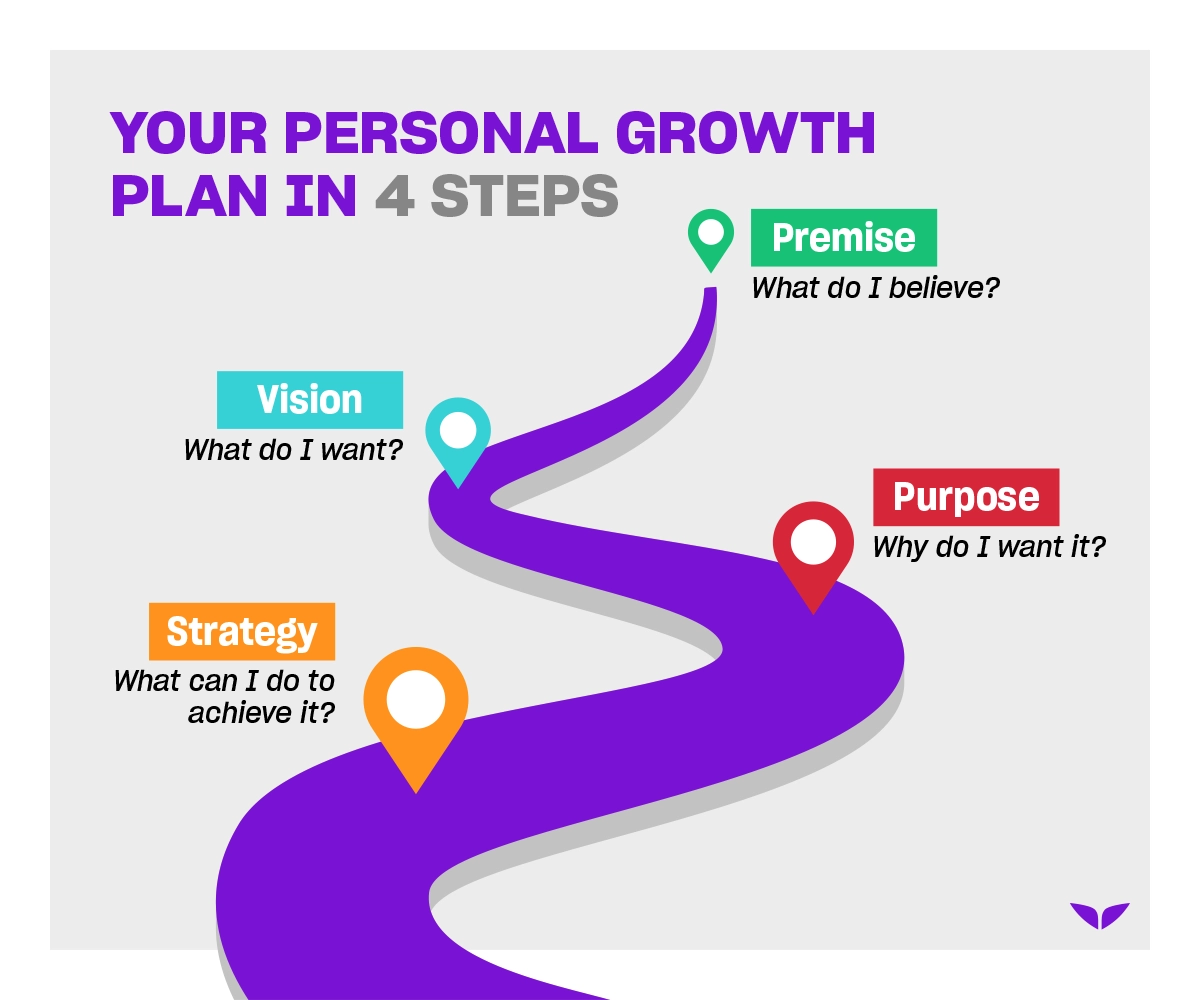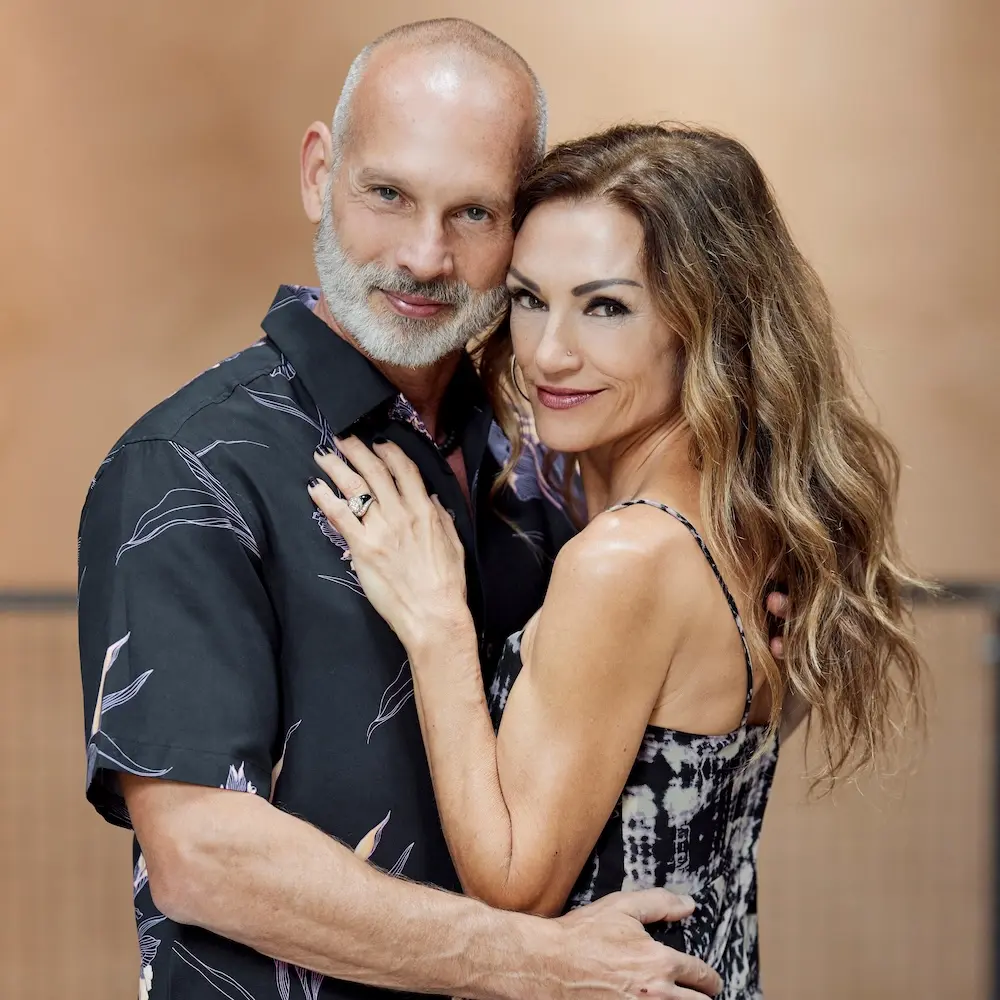Life can seem fine on the surface. But underneath? Messiness, chaos, and even overwhelm can ensue.
It’s something many of us experience—infinite distractions, endless choices, and responsibilities pulling us in all directions. No doubt, it’s easy to feel like all we’re doing amongst the noise and turbulence is drifting.
There is one thing that can help: a personal growth plan.
Sure, with it, you’re ticking off career goals and fitness targets. But it’s so much more than that. It’s about real transformation, achieving balance, and finding fulfillment in a world that’s anything but stable.
“You can have the life that you really want,” says Jon Butcher, the founder of Lifebook, in his Mindvalley Quest with the same name. And it starts with getting crystal clear on what truly matters to you and crafting a plan that reflects the life you’re meant to live.
What is a personal growth plan?
A personal growth plan is exactly what it sounds like—a conscious, deliberate strategy for how you want to evolve in different parts of your life. It helps you avoid drifting through day-to-day routines and empowers you to tackle challenges while steadily advancing toward your goals.
It’s different than traditional goal-setting, where it’s one aspect at a time. Instead, this self-improvement strategy touches on every crucial category: from health and relationships to finances, emotional well-being, and intellectual pursuits.
The thing is, many of us chase what society tells us will make us happy—more money, a better job, a bigger house—all without asking whether those things match our deeper values.
It’s kind of like Rachel Green from Friends: “It’s like all my life, everyone’s told me, ‘You’re a shoe!’ Well, what if I don’t want to be a shoe? What if I want to be a purse? Or a hat?”
According to Greta Siauciunaite, a certified happiness coach and Lifebook facilitator, this is one major mistake people tend to make. “People are not really tapping into what they want but they just look into what others are doing.”
But when you shift your focus to personal growth, you start to uncover what really matters. You gain clarity about who you are, what you truly want, and how to navigate the ups and downs of life.
And personal growth is not just about you; it’s also about those around you. As you grow, you become more self-aware, emotionally grounded, and fulfilled, which naturally improves your relationships. You connect better with others, support them, and make a greater impact in their lives.
As Jon puts it, “The instant you choose to start living your life on your own terms, that’s when everything changes.”
3 examples of a personal growth plan
When you feel stuck in life, the thought of personal growth can be daunting. Why should you do it? What do you do? Where do you even start?
Great questions—it all really boils down to finding a method that works for you. In all actuality, there’s no such thing as a one-size-fits-all journey.
Your life is yours; it’s unique to you and the answers you need to create an extraordinary life for yourself are inside of you, just waiting for you to uncover them.
— Jon Butcher, trainer of Mindvalley’s Lifebook Quest
Like, for Rachel, it was quitting her waitressing job at Central Perk to pursue her dream of working in fashion. But if that’s not your style, there are plenty of personal growth plan examples out there that might better resonate with you.
Here are three you can explore:
1. The SMART goal method
If you’ve got a few years into your professional journey, it’s likely you’ve heard of SMART goals. Not only is it a smart way of working toward what you want to achieve, but the letters are acronyms, each with its own unique function:
- Specific. The goal should be clear and detailed.
- Measurable. You need a way to track your progress.
- Achievable. The goal should be realistic and within your reach, based on your current resources and time.
- Relevant. The goal must align with your larger life objectives and values.
- Time-bound. Set a deadline or timeline to create urgency and a sense of accountability.
Let’s take fitness, for example. You might set a goal to run a 5 km race (specific) by tracking your progress and increasing your distance by 10% each week (measurable), aiming to achieve this over two months (achievable), as part of your plan to improve your overall health (relevant), with the race scheduled for the end of the two-month period (time-bound).
This method serves as a clear roadmap, making the process of your self-growth more manageable and less overwhelming.
2. The 7 habits approach
This framework comes from Stephen Covey’s The 7 Habits of Highly Effective People. He outlines seven key habits that can foster personal and professional effectiveness:
- Be proactive. Take control of your actions and reactions. Instead of just responding to what happens around you, focus on what you can actually change.
- Begin with the end in mind. Think about where you want to go in life. Whether it’s in your career, health, or relationships, imagine the end result and then figure out the steps that will get you there.
- Put first things first. Don’t just deal with what feels urgent; focus on what’s truly important for your long-term goals.
- Think win-win. When you work with others, aim for solutions that benefit everyone. This mindset helps build better relationships and fosters cooperation.
- Seek first to understand, then to be understood. Before jumping in with your own thoughts, take a moment to really listen to others. This makes communication clearer and helps you connect better.
- Synergize. Remember that combining different ideas often leads to the best results. It’s all about collaboration and bringing out the best in everyone.
- Sharpen the saw. Don’t forget to take care of yourself. Regularly recharge—whether that’s through exercise, learning, or relaxation—so you can keep growing and improving in all areas of life.
As Stephen writes in his book, “Happiness, like unhappiness, is a proactive choice.” And these seven steps can help you proactively build a life of growth and fulfillment.
3. Lifebook
While the first two methods focus on one aspect of growth at a time, Lifebook takes a different approach. It encourages you to create a clear vision for your entire life—12 aspects of it, in fact:
- Health and fitness
- Intellectual life
- Emotional life
- Character
- Spiritual life
- Love relationship
- Parenting
- Social life
- Financial life
- Career
- Quality of life
- Life vision
This holistic approach ensures that every part of your life is aligned with your values and aspirations, leaving no area neglected.
As Missy Butcher, the co-trainer of the Lifebook Quest on Mindvalley (who also happens to be Jon’s wife), says, “Lifebook is about getting to know yourself, and if you’re going to bullsh*t yourself, then you’re not going to believe yourself.”
What to include in a personal development plan
You can very well take the traditional route—you focus on one aspect at a time—if that’s what works best for you. However, if you’re looking for a more comprehensive personal development plan, you can consider Lifebook.
The beauty of it lies in understanding that the various aspects of life are deeply interconnected. When you improve one area, it naturally lifts the others, and vice versa.
That’s why it’s important to look at it all:
- Health and fitness: How you define physical well-being for long-term vitality.
- Emotional life: How you want to feel daily, including managing stress and cultivating positive emotions.
- Intellectual life: The skills or knowledge you want to gain to keep your mind sharp.
- Career: Consider what would bring you fulfillment in your work beyond simply earning a paycheck.
- Financial life: How you plan to manage and grow your finances for future goals.
- Love relationship: The quality of your romantic relationship and steps to improve it.
- Parenting: How you want to show up as a parent and nurture your child’s growth.
- Social life: The friendships and connections you want to build and maintain.
- Character: The virtues, like patience or resilience, that you want to develop.
- Spiritual life: Your spiritual beliefs and how you’ll regularly connect with them.
- Quality of life: The lifestyle, experiences, and surroundings that bring you joy.
- Life vision: A clear picture of the life you want to create over the next five, 10, or 20 years.
As you dive deeper into these categories, remember that only you can define what success looks like in your life.
“Your life is yours; it’s unique to you,” Jon points out. “And the answers you need to create an extraordinary life for yourself are inside of you, just waiting for you to uncover them.”
Develop a personal growth plan in 4 steps
A truly effective personal growth plan doesn’t have to be complicated. You don’t have to be like Rachel and leave her fiancé Barry at the altar because she doesn’t want to be a shoe.
Instead, when you’re looking into how to write a personal growth plan, you can reflect on the key areas of life so you can design an extraordinary one that works for you.

“When you have a crystal clear vision for the life that you want to be living, where you know exactly where you’re taking your entire life, [and] the person you want to become in the life that you want to live, then all of your goals are aligned,” says Jon. “They’re all directed at the same target.”
So here are four questions you can ask yourself for each area of your life, inspired by the Lifebook method:
1. Premise: What do I believe?
“Your beliefs control your thoughts, your decisions, and your behaviors, and therefore, your destiny,” Jon explains.
If they’re limiting, they can hold you back without you even realizing it. For example, if you think money is the root of all evil, then it doesn’t matter what kind of vision or strategy you have in place—you’ll likely unconsciously sabotage yourself financially.
Then again, if your beliefs are empowering, it could truly have the opposite effect. You could open up new possibilities.
The benefit of this reflection is gaining awareness of what’s driving your behavior. Once you identify those core beliefs, you can decide whether they’re empowering or need to be shifted.
2. Vision: What do I want?
Seeing those fancy lifestyles on social media can be addictive. But the reality is, what makes one person happy may not make you happy.
Just look at Rachel. While her best friend Mindy could do that whole marry-a-doctor-and-be-Mrs.-Doctor-Barry-Farber life, Rachel gave it up to live a more independent life—one that was outside of her family and her community’s expectations.
The key to this whole thing is clarity. Without being clear about what you want, you risk drifting through life or following someone else’s idea of success.
And once you are, you can focus your energy on making them happen.
3. Purpose: Why do I want it?
Research shows that having a clear purpose is crucial for finding meaning in life. When you reflect on your “why,” it keeps you going when things get tough, it gives your goals meaning, and it makes you more resilient.
Jon explains this idea well in the Lifebook Quest. “Most people want to make more money than they’re making right now. Well, why?” he asks. For nicer things? Better car? Bigger house?
“That’s an okay reason, I guess, but it’s probably not going to cause you to jump out of bed in the morning ready to tackle the day and really roll up your sleeves and do your absolute best.”
Instead, he suggests looking at the bigger picture—how financial success can bring freedom, reduce stress, and improve your overall well-being, physically, intellectually, and emotionally.
When your “why” is clear and personal, like wanting more financial freedom to enhance your quality of life, you’re much more likely to stay driven and focused on achieving your goals.
4. Strategy: What can I do to achieve it?
It’s great to have big goals, but unless you have a plan, they stay as wishes. Asking yourself this question forces you to break down those goals into actionable steps.
“Once we define the right strategies, then we’re going to be able to take focused intelligent action every day and just move closer and closer to our life vision consistently, step by step every day, every month, every year,” says Jon.
It’s essentially a roadmap that turns your vision into reality. Each small step—through daily habits, routines, or learning new skills—brings you closer. As you progress, the confidence and clarity you gain fuel even more momentum.
And remember, the key isn’t just having a plan but also being flexible enough to adapt and refine it as needed. This ensures you stay on course even when life throws challenges your way.
Dos and don’ts when creating a personal growth plan
As a Lifebook facilitator, Greta’s seen plenty… things that work and things that don’t. And she’s sharing a few simple dos and don’ts you’ll want to keep in mind when you’re creating a plan for self-improvement.
Dos
- Do make it your plan. Don’t create goals based on what others expect of you.
- Do take into consideration the long-term vision of how you want your life to look and feel.
- Do practice critical reflection. Dedicate time to listen to yourself and pen down what you want out of life.
- Do have a support system to share your victories and challenges with.
- Do stay flexible. Life will throw curveballs—learn to pivot without feeling like a failure.
Don’ts
- Don’t compare your journey with others. Your growth plan is unique to you.
- Don’t overload yourself with too many goals. Start small, and build momentum.
- Don’t select short-term goals that only feel good right now.
- Don’t forget to celebrate small wins. Every step forward is progress.
- Don’t get discouraged by setbacks. Failure is part of the process, so reframe it as an opportunity to learn and grow.
Ignite the extraordinary
Creating a personal growth plan is about taking charge of your life, just like Rachel Green in Friends realized she didn’t have to be a “shoe.”
If you’re ready to stop settling and start living life on your own terms, the How to Create Your Own Extraordinary Masterclass with Jon and Missy Butcher can guide you. Hosted by Vishen Lakhiani, this free prelude to the Lifebook Quest will help you design a personalized roadmap across all 12 dimensions of your life—so you can choose to be a purse, a hat, or anything else you dream of.

Just like Camille, a childcare owner and aspiring energy healer in the U.S. Before the program, was divorced with three kids and “filled with anger and exhaustion.” But while going through Lifebook, she rekindled a powerful love with her ex-husband, started three new businesses, lost 45 pounds in two months, and now parents with a positive attitude and compassion. “I’m so thankful and happy I found this amazing program and life path,” she shares on Mindvalley Stories.
Camille’s transformation shows what’s possible when you embrace this journey. And your extraordinary life can start today. All that’s waiting is for you to say “yes.”
Welcome in.










